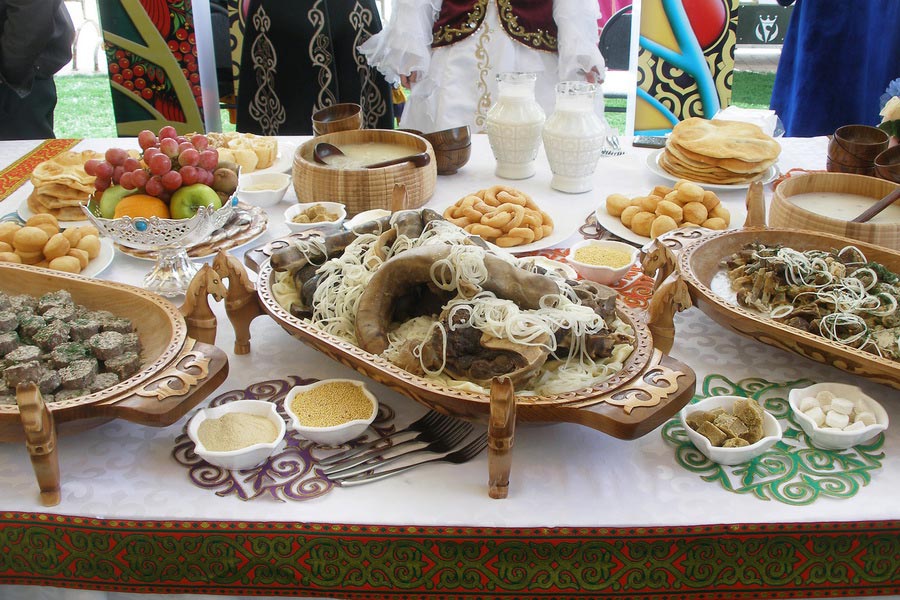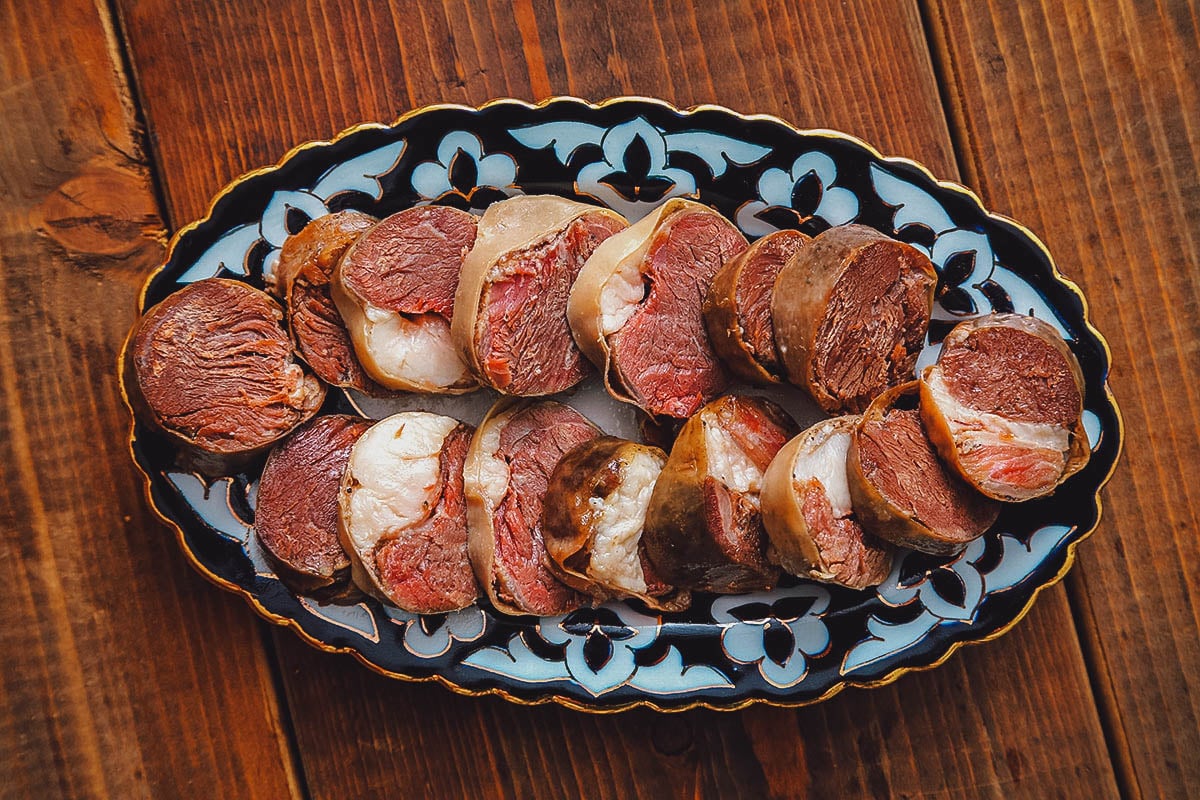Kazakh meals, a colourful tapestry of flavors and traditions, invitations us on a culinary journey that spans centuries and areas. From the nomadic roots of beshbarmak to the trendy fusion dishes that mix heritage with innovation, Kazakh delicacies captivates with its wealthy historical past, numerous elements, and fascinating flavors.
Right through this culinary exploration, we will be able to delve into the origins and influences that experience formed Kazakh delicacies, uncover the normal elements and dishes that outline its persona, and discover the regional permutations that mirror the rustic’s numerous panorama. We will be able to additionally witness the evolution of Kazakh meals in recent years, because it embraces trendy traits and good points world popularity.
Culinary Historical past of Kazakh Delicacies

The origins of Kazakh delicacies lie within the nomadic traditions of the Kazakh folks, who roamed the huge steppes of Central Asia for hundreds of years. Their delicacies is characterised via easy, hearty dishes that may be simply ready over an open hearth or in a cauldron.
Some of the key influences on Kazakh delicacies is the area’s local weather. The tough winters and scorching summers of the steppe have resulted in a reliance on preserved and dried meals, corresponding to kurt (dried fermented milk) and kazy (horse meat sausage).
Timeline of Key Culinary Occasions in Kazakh Historical past
- thirteenth century:The Mongol invasion of Central Asia brings new elements and cooking tactics to the area.
- sixteenth century:The Kazakhs develop into a definite ethnic team and broaden their very own distinctive culinary traditions.
- nineteenth century:Russian colonization introduces new vegetation and elements to Kazakhstan, corresponding to potatoes and tomatoes.
- twentieth century:The Soviet Union collectivizes agriculture in Kazakhstan, resulting in a decline in conventional nomadic practices and a shift in opposition to extra settled agriculture.
- Put up-independence:Kazakhstan regains its independence in 1991 and starts to restore its conventional culinary traditions.
Position of Nomadic Traditions in Shaping Kazakh Meals Tradition
The nomadic way of life of the Kazakhs has had a profound affect on their meals tradition. The want to commute gentle and be capable of get ready meals temporarily and simply resulted in the improvement of straightforward, transportable dishes. The reliance on cattle for sustenance additionally intended that meat, dairy, and different animal merchandise play a central position in Kazakh delicacies.
Nomadic traditions additionally influenced the way in which that Kazakhs maintain and retailer meals. The tough local weather of the steppe intended that meals had with the intention to face up to lengthy sessions of garage. This resulted in the improvement of tactics corresponding to drying, smoking, and fermenting.
Conventional Substances and Dishes
Kazakh delicacies is a mirrored image of the rustic’s nomadic heritage, characterised via hearty and flavorful dishes made with contemporary, in the community sourced elements. Those elements shape the root of conventional Kazakh foods, offering a novel and unique culinary revel in.
Here’s a desk showcasing one of the most key elements and dishes in Kazakh delicacies, in conjunction with their descriptions and utilization:
| Component/Dish | Description | Utilization in Kazakh delicacies | Symbol |
|---|---|---|---|
| Beshbarmak | A conventional Kazakh dish consisting of boiled horse or lamb meat served with noodles and a broth | A staple dish served on particular events and celebrations | [Image of Beshbarmak] |
| Kazy | One of those horse meat sausage seasoned with spices and garlic | Used as a major factor in Beshbarmak and different dishes | [Image of Kazy] |
| Kumys | A fermented mare’s milk beverage | A conventional drink ate up for its dietary and medicinal houses | [Image of Kumys] |
| Baursak | A deep-fried dough ball very similar to a donut | Served as a facet dish or dessert, ceaselessly accompanied via honey or jam | [Image of Baursak] |
Regional Permutations in Kazakh Delicacies

Kazakhstan’s huge territory and numerous landscapes give a contribution to regional permutations in its delicacies. Local weather, geography, and cultural influences form distinct culinary kinds around the nation.
Northern Kazakhstan
- Influenced via Russian and Siberian cuisines, that includes hearty soups, dumplings, and pastries.
- Examples: Beshbarmak(horse meat and noodles), Pelmeni(dumplings).
Central Kazakhstan
- Central location permits for a mix of influences from quite a lot of areas.
- Identified for its grilled meats, rice dishes, and dairy merchandise.
- Examples: Kuyrdak(grilled lamb), Pilaf(rice dish with meat and greens), Kumys(fermented mare’s milk).
Southern Kazakhstan
- Influenced via Central Asian cuisines, with a focal point on rice, lamb, and greens.
- Options dishes with a mix of candy and savory flavors.
- Examples: Plov(rice dish with lamb and greens), Samsa(pastries full of meat or greens).
Western Kazakhstan
- Stocks similarities with Russian and Ukrainian cuisines.
- Options soups, stews, and fish dishes.
- Examples: Borscht(beetroot soup), Ukrop(dill soup), Ryba po-Kazakhski(Kazakh-style fish).
Jap Kazakhstan
- Influenced via Chinese language and Mongolian cuisines.
- Identified for its noodles, dumplings, and dairy merchandise.
- Examples: Laghman(noodle soup), Manty(steamed dumplings), Ayran(fermented milk drink).
Kazakh Meals Gala’s and Celebrations
Meals holds immense importance in Kazakh tradition, and fairs and celebrations are not any exception. Those occasions provide a chance for households and communities to assemble, proportion scrumptious foods, and have a good time their heritage.
Conventional Dishes all over Celebrations
All over Kazakh fairs, conventional dishes are ready and ate up, every with its personal symbolic that means. Beshbarmak, a dish made with boiled horse meat, noodles, and broth, is a staple at many celebrations, representing hospitality and abundance. Different widespread dishes come with plov (rice pilaf), kuirdak (lamb stew), and baursak (fried dough balls).
Trendy Developments in Kazakh Delicacies
Kazakh delicacies, steeped in custom, has gone through a dynamic evolution in recent years. Recent culinary traits are leaving an indelible mark on conventional dishes, giving upward push to cutting edge and thrilling creations that mix the outdated with the brand new.
Rising Culinary Developments, Kazakh meals
- Fusion Delicacies:Kazakh cooks are experimenting with international flavors, incorporating components from quite a lot of cuisines into conventional dishes. This cross-cultural alternate has ended in distinctive and flavorful creations.
- Molecular Gastronomy:Tactics corresponding to sous vide and spherification are being hired to support the textures and flavors of conventional elements. This medical way to cooking provides a component of innovation and class.
- Sustainability:There’s a rising emphasis on the usage of native and seasonal elements, decreasing waste, and selling environmentally pleasant practices in Kazakh delicacies.
Leading edge Dishes
Those traits are obtrusive within the emergence of cutting edge dishes that push the bounds of conventional Kazakh delicacies:
- Beshbarmak with Truffle Foam:A vintage Kazakh dish of boiled horse meat and noodles is increased with a sumptuous truffle foam, including an earthy and umami taste.
- Kyimak Sorpa with Saffron and Pistachios:This conventional soup made with fermented dairy merchandise is infused with fragrant saffron and crunchy pistachios, making a harmonious mix of flavors and textures.
- Kazy with Molecular Glaze:Cured horse sausage, a staple in Kazakh delicacies, is reworked with a molecular glaze that complements its sweetness and provides a shiny end.
Those cutting edge dishes exemplify the dynamic evolution of Kazakh delicacies, the place custom meets modernity to create thrilling and remarkable culinary reviews.
Kazakh Delicacies within the World Context

Kazakh delicacies is rising in popularity international because of its distinctive flavors, use of clean elements, and nomadic heritage. Eating places, cookbooks, and social media play an important position in selling Kazakh meals tradition the world over.
Global Popularity
Kazakh cooks and meals fanatics have presented the arena to the delights of Kazakh delicacies. As an example, chef Mukhtar Mukhitdinovich has showcased Kazakh dishes at world culinary occasions, incomes accolades for his or her authenticity and creativity.
Cookbooks and Social Media
Cookbooks like “The Kazakh Cookbook” via Nurzada Sadykova supply detailed recipes and insights into Kazakh culinary traditions. Social media platforms corresponding to Instagram and YouTube characteristic meals bloggers and cooks sharing their reviews with Kazakh delicacies, inspiring a world target audience.
Questions Steadily Requested
What’s the nationwide dish of Kazakhstan?
Beshbarmak, a dish of boiled horse or lamb meat served with noodles and broth, is thought of as the nationwide dish of Kazakhstan.
What’s the preferred drink in Kazakhstan?
Kumys, a fermented mare’s milk, is a conventional and widespread beverage in Kazakhstan.
Is Kazakh meals highly spiced?
Whilst some Kazakh dishes incorporate spices, the delicacies is normally no longer regarded as highly spiced.
